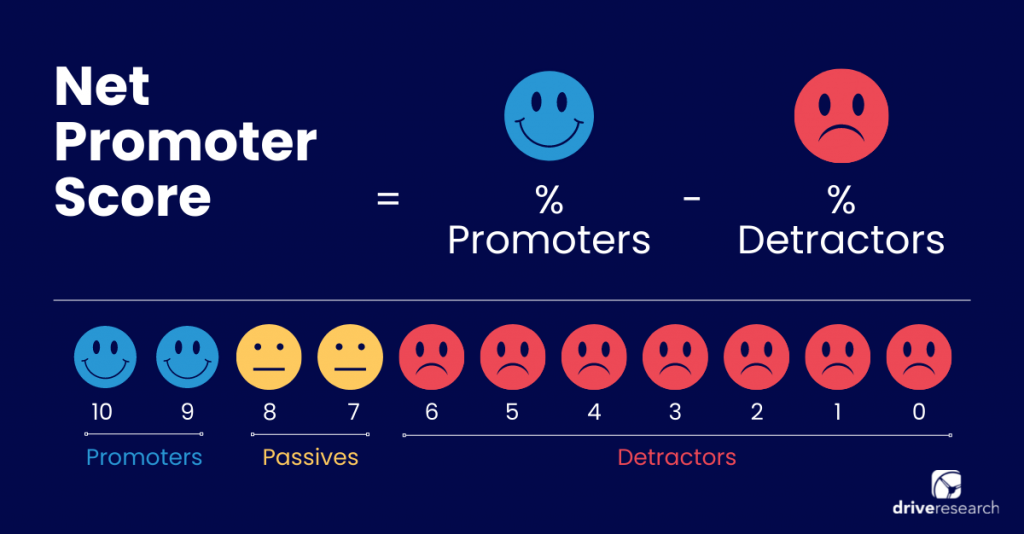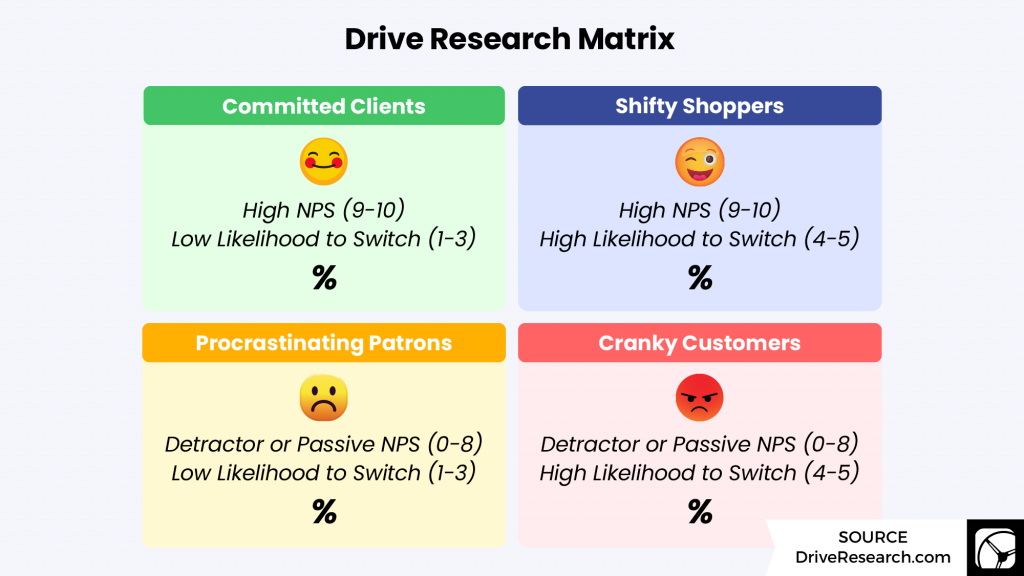
If you need to collect feedback from your customers or non-customers in your business-to-business (B2B) space, a survey is an excellent option.
That’s because developing and conducting B2B surveys offers several benefits to an organization. The simple fact of reaching out and listening to customer and non-customer thoughts carries some value in itself.
Although the greatest value is knowing the changes you make internally are guided by data-driven insights from your target audience, so you know organizational changes are well-aligned.
In this blog post, our B2B survey company shares our step-by-step process for creating and conducting B2B surveys, plus a real-world case study. Let’s get started!
What is a B2B Survey?
A B2B survey is a research method designed to gather feedback, insights, and data from businesses, professionals, or organizations that serve as customers or partners within a business-to-business (B2B) context.
This type of survey focuses on understanding the specific needs, preferences, challenges, and satisfaction levels of B2B respondents.
The impact of a B2B survey is huge as it aims to inform decision-making, product development, customer relationship management, and overall business strategies in the business-to-business environment.
How to Develop & Conduct a B2B Survey
Step 1: Determine Your Objectives
The first step of the B2B market research and survey process is to lay out your objectives. Determine what you want to learn from the audience, what your expectations are, and what you would like to do with the results.
Common objectives for B2B surveys include:
- Wanting to share the findings as part of a content marketing play
- Wanting to collect data to help guide your marketing channel usage and messaging to grow revenue
- Wanting to better understand the decision-making process of non-customers and why they choose competitors
This could be a combination of both areas that your organization wants to explore and possible recommendations from a consultant you work with.
This B2B market research company can suggest specific industry best practices including questions like Net Promoter Score (NPS), Customer Effort Score (CES), or other customer satisfaction metrics.
These benchmarks will help you compare your performance to key competitors in your industry or vertical.

Step 2: Decide on a Methodology (Or Not)
For this step, you may have a methodology in mind already or perhaps you are trying to determine which is best for your objectives and needs.
These methodologies can vary from social media data collection to online surveys, focus groups, in-depth interviews, phone surveys, or even mail surveys.
Each market research methodology offers its own unique pros and cons.
If you are unsure, a market research company like Drive Research can work with you to explain the options to you which vary in cost and timeframe.
Some of the best market research companies like ours will offer this advice as part of the quoting and proposal process at no charge.
Step 3: Collect a Quote or Proposal
One of the largest decisions you’ll have as part of the B2B survey process is to determine whether or not to use an independent third-party market research company or not. The pros of conducting in-house are the perceived in-house savings on costs.
However, completing a large undertaking like this in-house often pulls you away from other priorities and may actually take you longer and more hours than if you were to hire a B2B survey company.
The pros of using a third-party market research company for your B2B survey include:
- Eliminating bias and potential skews in data from conducting yourself
- Truthful and honest responses if respondents know results are going to a separate firm
- Leveraging the expertise and capabilities of a market research company that you may not have
- Obtaining a objective opinion on the results, data, and insights
At the very least, you should at least talk to a firm to receive a market research proposal. Here are 7 components of a market research proposal you’ll be able to read about when you receive it.
Step 4: Conduct the B2B Survey
So you’ve hammered out your objectives, methodology, and use of a B2B survey company. Once you decide to move forward with your B2B survey, the next step is to draft a survey instrument.
From there you will program the survey (for CATI or online) or format it for printing if you decide to go the mail route.
After this is complete you can run a test drive soft-launch before proceeding to a full launch. Once fieldwork is complete you’ll begin your analysis and reporting.
A B2B survey can take as little as 1 to 2 weeks or last several months depending on the number of desired completed surveys and whether or not you decide to use a market research company or not.
Step 5: Analyze the Results & Take Action
After fieldwork is closed, analyze the collected data to identify trends, patterns, and insights. Use can also use statistical methods to draw meaningful conclusions.
From there, you’ll want to interpret the survey results to gain actionable insights. Here it is important to identify strengths, weaknesses, opportunities, and areas for improvement based on the data.
Lastly, use the insights gained from the survey to inform business strategies, product improvements, customer interactions, and decision-making.
Example B2B Survey Questions
Here’s an inside look at the B2B survey questions our market research company recommends asking and why they are helpful. Before getting started, please note surveys created by our team are uniquely customized based on the needs of each client.
1. How likely are you to recommend [insert organization] to a friend or colleague? Select one.
Why this question is helpful: This question measures net promoter score (NPS), which is a commonly used customer satisfaction metric. While some organizations may solely rely on these ratings, our team prefers to use NPS as a piece of the CSAT puzzle. NPS has some additional benefits knowing there are benchmarks available to help organizations compare themselves to similar types of organizations.
2. Please explain why you rated your likelihood to recommend [insert organization] as a [insert response] out of 10. Enter your response below.
Why this question is helpful: Knowing an NPS is good, but understanding the drivers of that score is better.This question helps identify themes among customers with low, middle, and high NPS. Ultimately, this helps the team understand priorities for improvements/next steps.
3. On a scale from very important to not at all important, how important are each of the following factors when selecting a company to work with like [insert organization]? Select one for each.
4. On a scale from very satisfied to not at all satisfied, how satisfied are you with each of the following aspects of [insert organization]? Select one for each.
Why these question sets are helpful: These question sets measure importance and satisfaction for a specific list of factors/attributes of interest. Analysts use these scores to understand priority areas of improvement (i.e., high importance and low satisfaction), secondary areas of improvement (i.e., low importance and satisfaction), areas of success (i.e., high importance and satisfaction), and status-quo areas (i.e., low importance and high satisfaction).

5. If [insert organization] focused on doing one thing better to improve your satisfaction as a customer, what would it be? Enter your response below.
Why this question is helpful: It’s important to provide a space for customers to leave additional open-ended feedback as needed. This question is particularly powerful because it’s pointed/specific, but it’s also optional so customers are not forced to think of an answer. This helps keep communication open, while also keeping the survey short/concise.
B2B Survey Case Study
In today’s competitive business landscape, understanding customer satisfaction is a cornerstone of success for B2B companies.
In this section, we cover the journey of a recent B2B customer survey conducted by our market research team.
Learn more about the challenges, methodologies, and key takeaways that highlight the benefits of well-executed CSAT initiatives.
The Challenge
A B2B company partnered with Drive Research on a customer satisfaction survey (CSAT) initiative for account-based feedback.
The scope of work included surveying accounts twice a year with full-service support from our B2B survey company.
Key objectives of the B2B customer survey included:
- Capture CSAT and net promoter scores (NPS) across accounts
- Deliver consistent analysis of survey results to share and present to the client executive team
The Solution
Based on the client’s goals and objectives we recommended conducting a customer survey because it would allow us to directly gather feedback from their B2B customers.
By capturing CSAT and NPS ratings through surveys, we can gain quantitative measures of customer satisfaction and loyalty.
This data would provide the client with valuable insights into areas of improvement and strengths, enabling them to enhance customer relationships, refine their offerings, and address any concerns promptly.
The Approach
Our customer satisfaction company executed the project in a full-service fashion while working closely with the client to review and gain approval for the research design and materials before launching the study.
What does a full-service B2B survey entail?
Our team designed, fielded, and executed the online survey. We worked closely with the client team to review and approve the project timeline and all research materials.
Also, our analytics team managed and conducted each aspect of the project. This included survey design, sample planning, study execution, analysis, reporting, and consultation with the client.
Specific details of the overall plan included:
- A kickoff meeting to review prior work implications, objectives, and brainstorm research questions.
- Development of a short CSAT and NPS survey, in line with research objectives and desired learnings.
- Review and approval of final survey questions between Drive Research and the client team.
- Online setup, programming, and fieldwork to generate complete survey responses.
- Data analysis and sub-group analysis for multi-level understanding of results.
- Reporting of complete study results would be delivered in presentation format.
- 2 waves of survey research would be executed and reported on
- Virtual presentations of results (90 min) to the client’s executive leadership team.
The Results
While the specific results of the B2B customer survey remain confidential to the client, the partnership successfully addressed their objectives.
Following the consistent analysis of survey results, our team created a clear and data-driven presentation for their executive team.
This allowed us to walk through the report and highlight our recommendations for how the data can be used to make informed decisions.
Frequently Asked Questions About B2B Surveys
What is the difference between B2B & B2C surveys?
B2B surveys focus on businesses as respondents, gathering insights about professional needs, decision-making processes, and long-term relationships. B2C surveys target individual consumers, focusing on personal preferences, buying behavior, and short-term experiences.
How do you survey B2B customers?
Surveying B2B customers involves crafting questions tailored to business contexts, understanding their pain points, preferences, and ROI expectations. Utilize channels like email, phone interviews, or online forms and offer incentives to encourage participation.
How do I create a B2B survey?
To create a B2B survey, define clear objectives, identify your target audience, craft relevant questions addressing their business needs, design a user-friendly survey layout, and pilot test before deploying to ensure effectiveness and accurate data collection.
Contact Our B2B Survey Company
Drive Research is a B2B market research and B2B survey firm. Our market research company has conducted many B2B studies across the country with a variety of industries.
Interested in learning more or receiving a quote? Contact us today.



